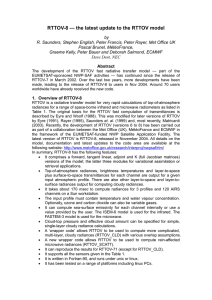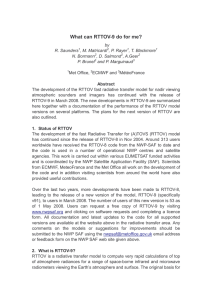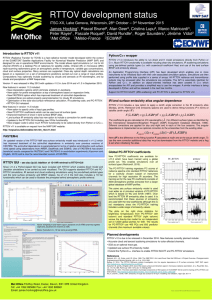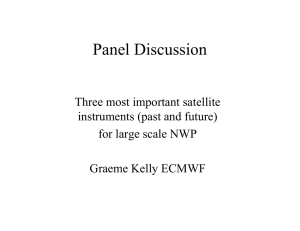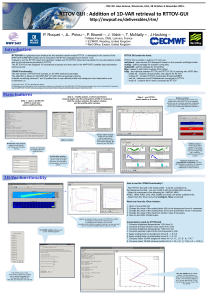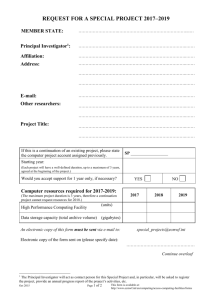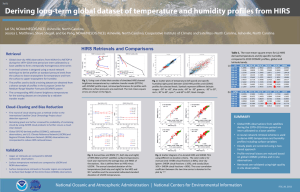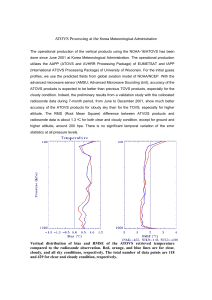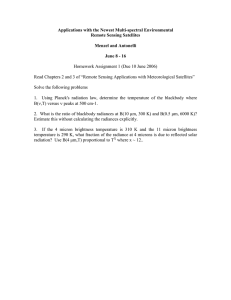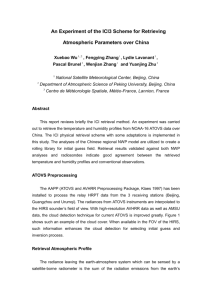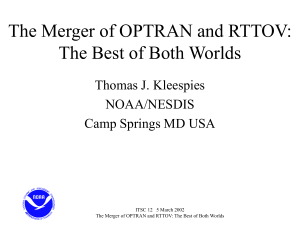RTTOV-7: A Satellite Radiance Simulator for the New Millennium
advertisement
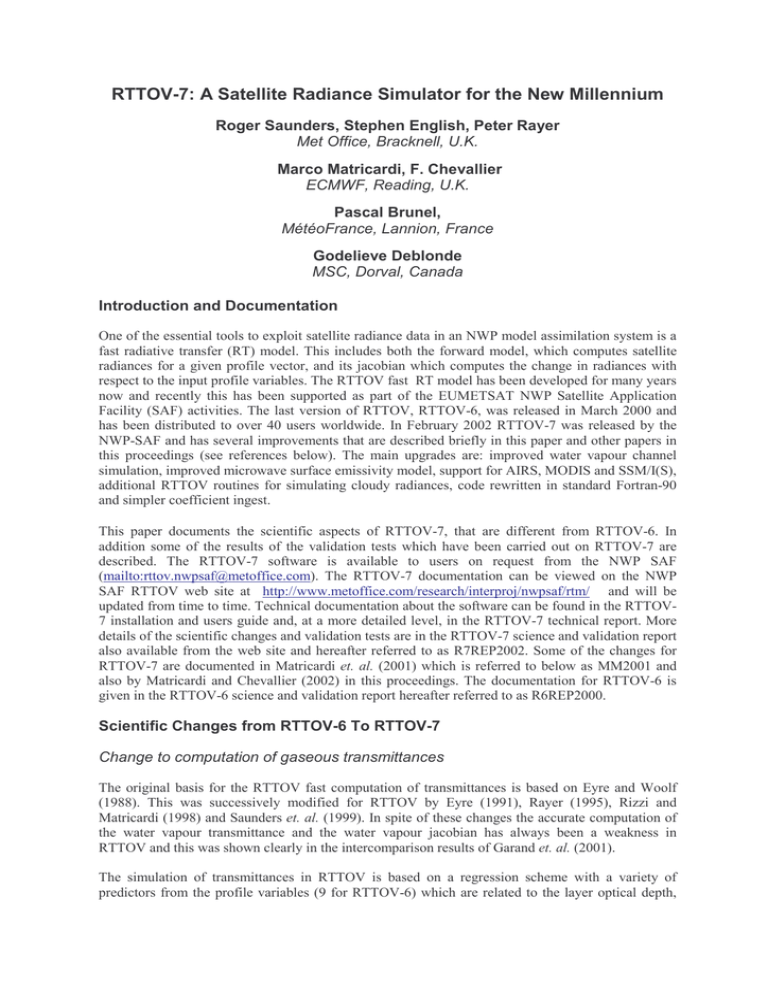
RTTOV-7: A Satellite Radiance Simulator for the New Millennium Roger Saunders, Stephen English, Peter Rayer Met Office, Bracknell, U.K. Marco Matricardi, F. Chevallier ECMWF, Reading, U.K. Pascal Brunel, MétéoFrance, Lannion, France Godelieve Deblonde MSC, Dorval, Canada Introduction and Documentation One of the essential tools to exploit satellite radiance data in an NWP model assimilation system is a fast radiative transfer (RT) model. This includes both the forward model, which computes satellite radiances for a given profile vector, and its jacobian which computes the change in radiances with respect to the input profile variables. The RTTOV fast RT model has been developed for many years now and recently this has been supported as part of the EUMETSAT NWP Satellite Application Facility (SAF) activities. The last version of RTTOV, RTTOV-6, was released in March 2000 and has been distributed to over 40 users worldwide. In February 2002 RTTOV-7 was released by the NWP-SAF and has several improvements that are described briefly in this paper and other papers in this proceedings (see references below). The main upgrades are: improved water vapour channel simulation, improved microwave surface emissivity model, support for AIRS, MODIS and SSM/I(S), additional RTTOV routines for simulating cloudy radiances, code rewritten in standard Fortran-90 and simpler coefficient ingest. This paper documents the scientific aspects of RTTOV-7, that are different from RTTOV-6. In addition some of the results of the validation tests which have been carried out on RTTOV-7 are described. The RTTOV-7 software is available to users on request from the NWP SAF (mailto:rttov.nwpsaf@metoffice.com). The RTTOV-7 documentation can be viewed on the NWP SAF RTTOV web site at http://www.metoffice.com/research/interproj/nwpsaf/rtm/ and will be updated from time to time. Technical documentation about the software can be found in the RTTOV7 installation and users guide and, at a more detailed level, in the RTTOV-7 technical report. More details of the scientific changes and validation tests are in the RTTOV-7 science and validation report also available from the web site and hereafter referred to as R7REP2002. Some of the changes for RTTOV-7 are documented in Matricardi et. al. (2001) which is referred to below as MM2001 and also by Matricardi and Chevallier (2002) in this proceedings. The documentation for RTTOV-6 is given in the RTTOV-6 science and validation report hereafter referred to as R6REP2000. Scientific Changes from RTTOV-6 To RTTOV-7 Change to computation of gaseous transmittances The original basis for the RTTOV fast computation of transmittances is based on Eyre and Woolf (1988). This was successively modified for RTTOV by Eyre (1991), Rayer (1995), Rizzi and Matricardi (1998) and Saunders et. al. (1999). In spite of these changes the accurate computation of the water vapour transmittance and the water vapour jacobian has always been a weakness in RTTOV and this was shown clearly in the intercomparison results of Garand et. al. (2001). The simulation of transmittances in RTTOV is based on a regression scheme with a variety of predictors from the profile variables (9 for RTTOV-6) which are related to the layer optical depth, (di,j - di,j-1 ), where di,j is the level to space optical depth from level j and channel i. The regression is actually performed in terms of its departure from a reference profile, for mixed gases, water vapour or ozone. For RTTOV-6 and earlier models the formulation is: d i , j = d i , j −1 + Y j K k =1 ref ai , j ,k X k , j + (d iref , j − d i , j −1 ) (1) where K is the number of predictors and their definition (i.e. Xk,j and Yj ) are given in Tables 1 and 2 of R6REP2000 and ai,j,k are the regression coefficients. For RTTOV-7 the formulation changes slightly to predict the layer optical depth directly rather than its departure from a reference optical depth: di, j = di, j −1 + K k =1 i , j ,k a X k, j (2) The new predictors are given in Tables 1 and 2 of R7REP2002 and are a development of those used in RTIASI described in Matricardi and Saunders (1999). For the mixed gases there are now 10 predictors, for water vapour 15 and for ozone 11. Another difference from the old formulation is that the new predictors are defined by taking the ratio with the reference profile compared with the differences (see Tables 2 of R6REP2000 and R7REP2002). This is believed to be one reason for the improved accuracy. Another is that the predictors themselves have been better formulated to simulate water vapour line and continuum absorption separately. A third difference is that in the computation of the regression coefficients, layers that do not contribute significantly to the top of atmosphere radiance are down weighted. Finally the coefficients were computed from transmittances for 6 viewing angles in the range 0 to 63.6 deg in contrast to RTTOV-5/6 which were for 5 viewing angles from 0 to 60 deg. This helps to improve the simulation of geostationary imager radiances close to the edge of the earth's disk. Addition of improved microwave surface emissivity model, FASTEM-2 RTTOV-5/6 included a microwave surface emissivity model FASTEM-1 (English and Hewison, 1998) to compute ocean surface emissivity given a sea surface temperature, surface wind speed and viewing angle for a microwave radiometer channel. This has been successfully used for cross-track scanners (e.g. AMSU) close to nadir but there have been concerns over its simulation of sea surface emissivities for conical scanners (i.e. SSM/I) in particular the sensitivity to wind speed at a combination of low wind speeds and large zenith angles. As a result Deblonde and English (2001) have developed an improved version called FASTEM-2 which takes into account the treatment of non-specular reflection within RTTOV. This has significantly improved the simulation of ocean surface emissivity for SSM/I and AMSU for larger viewing angles as described in Deblonde (2000). The RTTOV-7 code has been developed to allow either FASTEM-1 or FASTEM-2 to be invoked according to the user inputs. In addition to improving the ocean surface microwave emissivity RTTOV-7 also includes the capability to simulate land/sea-ice microwave surface emissivities. This makes use of 5 coefficients that vary for different land surface types, which allows the emissivity as a function of frequency to be computed. Inclusion of cosmic background radiation The microwave ‘window’ channels can have a significant proportion of downwelling reflected radiation included in the simulated top of atmosphere upwelling radiance. Part of the downwelling component will be cosmic background radiation at a mean radiative temperature of 2.7K. RTTOV-6 and earlier versions assumed this was zero. The differences between neglecting this component can be as great as 1.7% in radiance (1.2 degK) for the horizontally polarised 19 GHz channel of SSM/I but is typically a third of this for the vertically polarised channel due to higher surface emissivity. Additional functionality for computing multi-layer cloudy radiances Prior to RTTOV-7 the computation of cloudy infrared radiances assumed cloud tops at a single pressure level with an effective fractional cloud amount from 0 - 100% (which could include nonunit emissivity). RTTOV-7 has been enhanced to allow cloud absorption to be taken into account based on the ECMWF broad-band radiation scheme (Morcrette, 1991). Clouds are assumed to be grey bodies, within each channel spectral range, with their contribution to the radiances computed from their horizontal coverage ni, and their emissivity ενi in each vertical layer i of the user's model. ενi is derived from the cloud liquid and/or ice water path li by the relationship: ενi = 1 − e− l kν i i (3) where kν is the extinction coefficient at a frequency ν . Its value varies according to the phase of the cloud water, the particle sizes and the temperature. The coefficients of the linear combination of clear and cloudy radiances are functions of ni and ενi and depend on the way the cloudy layers overlap. The maximum-random hypothesis (Raïsänen, 1998) is adopted as it explicitly distinguishes between the horizontal coverage and the emissivity of the cloud layers. Cloud absorption is taken into account in the infrared spectrum following Ebert and Curry (1992) for ice water and Smith and Shi (1992) for liquid water. The water droplet radius is set to 10 m over land and 13 m over sea and the ice i crystal radii varies between 30 and 60 m with a temperature dependence from Ou and Liou (1995). Cloud absorption is introduced in the microwave (1-200 GHz) as a function of frequency and liquid water/ice content following Hufford (1991) for ice and Liebe et. al. (1989) for water clouds. Precipitation effects are not taken into account. More details of this cloud scheme and comparisons with HIRS and MSU are given in Chevallier et. al. (2001). Refinements in Line-by-Line model database The RTTOV-7 model is based on the same line-by-line (LbL) model transmittances as used for RTTOV-5/6. However since the release of RTTOV-6 several minor problems with these datasets have come to light and have been corrected as described in R7REP2002. Addition of new instruments Many more infrared and microwave sensors can now be simulated with RTTOV-7 (and most with RTTOV-6 also). The current list of supported instruments and the platforms they are on is listed in Table 1. Testing and Validation of RTTOV-7 An extensive set of validation tests were applied to the new model before it was released. These are described below together with some results for ATOVS. Not all aspects of the model validation are described in detail here, more details are given in R7REP2002, the FASTEM-2 validation is described in Deblonde (2000), the gaseous transmittance validation in MM2001 and for cloudy infrared and microwave radiance simulations in Chevallier et. al. (2001). The model is validated in several ways. Firstly the RTTOV-6 and RTTOV-7 gaseous level to space transmittances are compared with the LbL model transmittances for the dependent 43 profile dataset. This tests the accuracy of the parameter the model actually simulates by comparing with the dependent set. Secondly the RTTOV top of atmosphere brightness temperatures are compared with those computed using the LbL model transmittances from the dependent profile sets and in addition the transmittances from the 117 ECMWF profile independent set (Chevallier, 2001). This tests the accuracy of the brightness temperatures simulated by RTTOV-7 but disregarding errors coming from the LbL model. Thirdly the RTTOV top of atmosphere radiances have been compared with those from other infrared and microwave LbL models to test the accuracy of RTTOV including errors due to the LbL models used to train RTTOV-7. Finally the RTTOV radiances have been compared with observed ATOVS radiances using NWP analyses to provide the profile. The RTTOV jacobians have also been compared for ATOVS channels using the dataset prepared by Garand et al. (2001). This allows a comparison with several different models. They have also been compared with jacobians from SYNSATRAD for HIRS and METEOSAT (see MM2001) and with Gastropod for AIRS (Sherlock et. al. 2002). Table 1. Platforms and sensors supported by RTTOV-7 as at 1 Jan 2002. Platform/Sensor Sat ids Channels NOAA HIRS 6-16 1 to 19 NOAA MSU 6-14 1 to 4 NOAA SSU 6-14 1 to 3 NOAA AMSU-A 15-16 1 to 15 NOAA AMSU-B 15-16 1 to 5 NOAA AVHRR 6-16 3b to 5 DMSP SSMI 8-15 1 to 7 NOAA VTPR1 2-5 1 to 8 TRMM TMI 1 1 to 9 DMSP-SSMIS 16 1 to 24∗ AQUA-AIRS 1 to 2378 TERRA MODIS 1 to 17 ERS ATSR 1-2 1 to 3 + METEOSAT 5-7 1 to 2 MSG SEVIRI 1 4 to 11 GOES-Imager 8-12 1 to 4 GOES-Sounder 8,10,11 1 to 18 GMS imager 5 1 to 2 FY2-VISSR 2 1 to 2 FY1-MVISR 3-4 1 to 3 *channels 19-21 are not simulated accurately + Meteosat 2-4 to be added soon The validation results described below are for ATOVS but the performance of the model for all new instruments has been checked in terms of transmittance differences from the LbL model and compared to similar channels in the above sensors. Results for more sensors are given in R7REP2002 and MM2001. Validation of ATOVS transmittances As a result of the improved gaseous transmittance prediction scheme described above changes are observed when comparing the transmittance predictions of RTTOV-6 and RTTOV-7 for HIRS and AMSU channels. The rms of the transmittance differences (in units of 0-100%) from the Line-byLine (LbL) transmittances are shown in Figure 1 for a selection of those HIRS channels most affected by the change from RTTOV-6 to RTTOV-7. These statistics are for 5 different viewing angles in the range 0 to 60 deg. The 43 dependent profile set is used with ozone absorption (which is small for the channels plotted) held constant. As shown in Figure 1 there are significant reductions in rms for RTTOV-7 over RTTOV-6 at all levels especially for HIRS channels 11 and 12. AMSU-B water vapour channels (not shown) also have significant improvements in all channels. Validation of top of atmosphere radiance For both the dependent and independent profile sets brightness temperatures have been computed using the radiative transfer formulation within RTTOV-7 and the LbL model transmittances to ensure any differences are only due to the LbL and fast model transmittances not the integration of the radiative transfer through the atmosphere. Figure 2 compares the standard deviations and biases of the fast model minus LbL model NOAA-15 ATOVS brightness temperatures for the last three versions of RTTOV (5-7) to show how they have improved with each new version. The plot shows for RTTOV-7 the standard deviation of the difference is less or the same compared with RTTOV-5/6 for all channels with the exceptions being AMSU-A channels 9-12 (ATOVS channels 29-32). However for these AMSU-A stratospheric channels the increase in variance is small in absolute terms (~0.01K). The major improvement from RTTOV-5 to RTTOV-6 was in the AMSU-B water vapour channels and AMSU-A tropospheric sounding channels. For RTTOV-6 to RTTOV-7 the major improvement has been in the HIRS water vapour and ozone channels although some improvements in the AMSU-B water vapour channels are also evident. The mean biases are all less than 0.08K for RTTOV-7. Also plotted in Figure 2 are the NOAA-15 ATOVS instrument noise values for each channel which demonstrates the RTTOV-7 errors are now well below the instrument noise for all channels. Comparisons of ATOVS observations with ECMWF NWP model fields showed the mean scan angle dependence of the observed–model bias for several latitude bands is reduced for the angles away from nadir for RTTOV-7 for HIRS channels 10-12. The global mean time series of the radiance biases for the two models were also examined for the ATOVS channels but although the biases were slightly different for RTTOV-7 compared with RTTOV-5 there was no significant reduction showing these biases are dominated by errors other than those from the RT model. Validation of jacobians The accuracy of the jacobians computed by RTTOV are important to document for the radiance assimilation users as they are instrumental in modifying the NWP model analysis variables. MM2001 and R7REP2002 describe several different sets of validation results. The most comprehensive comparison of jacobians with other models was carried out by Garand et al. (2001) who included results from RTTOV-5 and RTTOV-6 along with several LbL models for a selection of HIRS and AMSU channels. Garand et. al. (2001) showed that RTTOV-6 exhibited some anomalous features in the water vapour jacobians of HIRS channel 12. RTTOV-7 has now been compared with this dataset and the values for ‘goodness of fit’, M, are documented in MM2001 for temperature, water vapour and ozone jacobians of a selection of HIRS channels for 5 diverse profiles used by Garand et. al. (2001). For the HIRS temperature sounding channels (2-5, 15) RTTOV-7 has similar values for M but for the water vapour and ozone channels (9 –12) significant reductions in values for M are evident in both temperature and water vapour or ozone jacobians. In contrast to RTTOV-6, for RTTOV-7 the values for M are now almost all below 10. A more comprehensive comparison of HIRS and METEOSAT RTTOV jacobians has also been carried out described in MM2001 and R7REP2002. For AMSU channels listed in REP72002 there is no significant change between the two models in terms of fit to the MWLBL model jacobian with the exception of AMSU channel 18 which is improved. Summary RTTOV-7 has been shown to be an overall improvement to the previous model RTTOV-6 particularly for the infrared water vapour and ozone channels as demonstrated by the various validation results for ATOVS presented in this report. It now supports a wider range of satellite instruments including high resolution infrared sounders. Cloudy infrared and microwave radiances with fractional cloud cover at different levels and different emissivities can now be modelled with new additional routines distributed with RTTOV. The modelling of the surface emissivity at microwave frequencies has also been improved. Users of the code are invited to submit comments for improvements or report bugs to mailto:rttov.nwpsaf@metoffice.com. An RTTOV email newsgroup exists to share experiences, report bugs and broadcast information on updates to the coefficient files or code. Just send a request to this email to be included on the newsgroup. Acknowledgements The RTTOV-7 developments and validation described here were carried out as part of the activities of the SAF for NWP, partially funded by EUMETSAT. References Chevallier, F. 2001 TIGR-like sampled databases of atmospheric profiles from the ECMWF 50 level forecast model. NWP-SAF report 1. NWP SAF Report available from ECMWF librarian. Chevallier, F., P. Bauer, G. A. Kelly, C. Jakob, and T. McNally, 2001 Model clouds over oceans as seen from space: comparison with HIRS/2 and MSU radiances. J. Climate 14 4216-4229. Deblonde, G. 2000 Evaluation of FASTEM and FASTEM-2. NWP SAF Report available from RTTOV web site: http://www.metoffice.com/research/interproj/nwpsaf/rtm/ Deblonde, G. and S.J. English 2001 Evaluation of the FASTEM-2 fast microwave oceanic surface emissivity model. Tech. Proc. ITSC-XI Budapest, 20-26 Sept 2000 67-78 Ebert, E.E. and J. A. Curry 1992 A parametrization of ice optical properties for climate models. J. Geophys. Res., 97, 3831-3836. English S.J. and T.J. Hewison 1998 A fast generic millimetre wave emissivity model. Microwave Remote Sensing of the Atmosphere and Environment Proc. SPIE 3503 22-30 Eyre J.R. and H.M. Woolf 1988 Transmittance of atmospheric gases in the microwave region: a fast model. Applied Optics 27 3244-3249 Eyre J.R. 1991 A fast radiative transfer model for satellite sounding systems. ECMWF Research Dept. Tech. Memo. 176 (available from the librarian at ECMWF). Garand, L., Turner, D.S., Larocque, M., Bates, J., Boukabara, S., Brunel, P., Chevallier, F., Deblonde, G., Engelen, R., Hollingshead, M., Jackson, D., Jedlovec, G., Joiner, J., Kleespies, T., McKague, D.S., McMillin, L., Moncet, J. L., Pardo, J. R., Rayer, P. J., Salathe, E., Saunders, R., Scott, N. A., Van Delst, P., Woolf, R. 2001 Radiance and jacobian intercomparison of radiative transfer models applied to HIRS and AMSU channels. J. Geophys. Res., 106, D20. 24,017-24031. Hufford, G. 1991 A model for the complex permittivity of ice. Int. J. Infrared and Millimeter Waves 12 677681. Liebe, H., J.T. Manabe and G. Hufford 1989 Millimeter wave attenuation and delay rates due to fog/cloud conditions. IEEE Trans. Antennas Propag., 37, 1617-1623. Matricardi M and R.W. Saunders 1999 A fast radiative transfer model for simulation of IASI radiances. Applied Optics 38 5679-5691. Matricardi, M., F. Chevallier and S. Tjemkes 2001 An improved general fast radiative transfer model for the assimilation of radiance observations. ECMWF Research Dept. Tech. Memo. 345 (available from the librarian at ECMWF). Matricardi, M and F. Chevallier 2002 An improved general fast radiative transfer model for the assimilation of radiance observations. In Tech. Proc. of ITSC-XII Lorne, Australia, 26 Feb – 5 Mar, 2002. Morcrette, J.J. 1991 Radiation and cloud radiative properties in the ECMWF forecasting system. J. Geophys. Res.96 D5 9121-9132. Ou S.-C. and K.-N. Liou 1995 Ice microphysics and climatic temperature feedback. Atmos. Res. 35 127-138. R6REP2000 2000 RTTOV-6 Science and Validation report. NWP SAF report available from RTTOV web site: http://www.metoffice.com/research/interproj/nwpsaf/rtm/ R7REP2002 2002 RTTOV-7 Science and Validation report. NWP SAF report available from RTTOV web site: http://www.metoffice.com/research/interproj/nwpsaf/rtm/ Räisänen, P. 1998 Effective longwave cloud fraction and maximum-random overlap clouds- a problem and a solution. Mon. Wea. Rev. 126 3336-3340. Rayer P.J. 1995 Fast transmittance model for satellite sounding. Applied Optics, 34 7387-7394. Rizzi, R. and M. Matricardi 1998 The use of TOVS clear radiances for numerical weather prediction using an updated forward model. QJRMS, 124 1293-1312 Saunders R.W., M. Matricardi and P. Brunel 1999 A fast radiative transfer model for assimilation of satellite radiance observations - RTTOV-5. ECMWF Research Dept. Tech. Memo. 282 (available from the librarian at ECMWF). Sherlock, V.J., A. Collard and R. Saunders 2002 Development and validation of Gastropod, a fast radiative transfer model for the advanced sounders. In Tech. Proc. of ITSC-XII Lorne, Australia, 26 Feb – 5 Mar, 2002. Smith, E.A. and L. Shi 1992 Surface forcing of the infrared cooling profile over the Tibetan plateau. Part I: Influence of relative longwave radiative heating at high altitude. J. Atmos. Sci. 49 805-822. 0 Pressure (hPa) 200 400 600 800 HIRS−8 HIRS−10 HIRS−11 HIRS−12 1000 0.0 0.5 1.0 1.5 2.0 RMS Differences in Transmittance Figure 1 RMS differences of RTTOV-6 (bold lines) and RTTOV-7 (faint lines) for NOAA16 HIRS channel transmittance differences from the LbL model for 43 TIGR profiles and 5 viewing angles. NOAA-15 ATOVS St. dev of mean difference from LbL model for 117 independent ECMWF profiles 1.2 RTTOV-5 RTTOV-6 RTTOV-7 Sdev of Fast -LbL degK 1 NeDT 0.8 0.6 0.4 0.2 0 1 2 3 4 5 6 7 8 9 10 11 12 13 14 15 16 17 18 19 21 22 23 24 25 26 27 28 29 30 31 32 33 34 35 36 37 38 39 40 Channel number NOAA-15 ATOVS Bias of mean difference from LbL model for 117 independent ECMWF profiles 0.2 RTTOV-5 0.15 RTTOV-6 RTTOV-7 Fast -LbL degK 0.1 0.05 0 1 2 3 4 5 6 7 8 9 10 11 12 13 14 15 16 17 18 19 21 22 23 24 25 26 27 28 29 30 31 32 33 34 35 36 37 38 39 40 -0.05 -0.1 -0.15 Channel number Figure 2 Standard deviation (upper panel) and bias (lower panel) of RTTOV-5, 6 and 7 top of atmosphere brightness temperature differences from LbL model for the 117 independent profile set and 5 viewing angles for NOAA-15 ATOVS. Channels 1-19 = HIRS; 21-35 = AMSU-A; 36-40 = AMSU-B. A surface emissivity of 1 is assumed for all channels.
